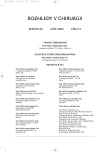Současný stav antimikrobní léčby sekundární peritonitidy
A Contemporary Situation in the Antimicrobial Treatment of the Secondary Peritonitis
Peritonitis infection is polymicrobial, with the following prevailing pathogens – gram-negative aerobic and anaerobic bacteria and anaerobic cocci. Treatment of the secondary peritonitides includes surgical management of the infectious focus, initial empiric antimicrobial therapy and intensive adjunctive therapy aimed to control any secondary and terciary disorders.
Materials, Methods and Results:
Based on the results of the actual sensitivity of each pathogen of the intraabdominal infections and on the results of the past restrospective clinical studies, recommendations for initial empiric antimicrobial therapy of the secondary peritonitis have been compiled. Sensitivity of aerobic pathogens to parenterally administered antibiotics in the secondary peritonitits was regulary recorded and the results were summarized in 2004. The minimum inhibition concentrations (MIC in mg/l for the anaerobic bacteria and cocci are presented, based on present data of the National Reference Laboratory for Anaerobic Bacteria. A comparative retrospective study of the antimicrobial treatment in the secondary peritonitis from perforation of the diverticle of the large intestine, proved comparable results between treatment with antimicrobial monotherapy (piperacillin/tazobactam) and combined therapy (aminoglycosides with lincosamides or with nitroimidasoles). The effect of antimicrobial prophylaxis and therapy (aminopenicillines with the beta-lactamase inhibitor) was assessed in another restrospective study in acute appendicitis. The recommendations for initial empiric antimicrobial therapy in the secondary peritonitis are based on clinical and peroperative findings, on an estimated prevalence of the pathogens in the infectious focus and on sensitivity results of the individual antimicrobial medicines to the commonest pathogens in the secondary peritonitis.
Results:
1. Initial empiric antimicrobial treatment in the secondary peritonitis as a monotherapy with a broad-spectrum antibiotic or a combination of two antibiotics, should be effective against gram-negative aerobic, anaerobic bacteria and cocci. 2. With respect to morbidity and mortality rates, related to enterococcus infection not affected by antimicrobial therapy, administration of an antibiotic effective against enterococci is justified. 3. The choice of an antibiotic, duration and method of administration is based on the diagnosed infectious focus, peritonitis stage, on the current sensitivity findings of the commonest pathogens and on the overall condition of the patient (underlying disorders, immunodeficiency). 4. Treatment of other pathogens – Pseudomonas aeruginosa and mycoses is based on their laboratory confirmation and their sensitivity examination and usually is not an essential part of the initial empiric treatment. 5. In the initial empiric treatmet of early stages of the peritonitis, aminopenicilllin with the beta-lactamase inhibitor is the antibiotic of choice. 6. Due to its broad-spectrum effect against isolated bacteria and the safety parameters and low toxicity when used as monotherapy, pipracillin/tazobactam is indicated as the antibiotic of choice in advanced peritonitides with underlying disorders of the aboral part of the digestive tract.
Key words:
secondary peritonitis – antimicrobial treatment – monotherapy – combined treatment
Autoři:
F. Vyhnánek; J. Vranková
Působiště autorů:
Mikrobiologický ústav 3. LF UK Praha, přednosta doc. MUDr. M. Bednář, CSc.
; Chirurgická klinika 3. LF UK Praha, přednosta doc. MUDr. J. Fanta, DrSc.
Vyšlo v časopise:
Rozhl. Chir., 2005, roč. 84, č. 9, s. 466-471.
Kategorie:
Monotematický speciál - Původní práce
Souhrn
Infekce u zánětu pobřišnice je polymikrobiální s nejčastějšími patogeny – gramnegativní aerobní a anaerobní bakterie a anaerobní koky. Léčba sekundárních peritonitid obsahuje chirurgické ošetření zdroje infekce, iniciální empirickou antimikrobní léčbu a intenzivní podpůrnou terapii směřující ke kontrole sekundárního a terciálního poškození.
Materiál, metoda a výsledky:
Na základě výsledků aktuální citlivosti jednotlivých patogenů nitrobřišních infekcí a výsledků předchozích retrospektivních klinických studií byla vypracována doporučení pro iniciální empirickou antimikrobní léčbu sekundární peritonitidy. Při pravidelném sledování citlivosti aerobních patogenů na parenterálně podávaná antibiotika u sekundární peritonitidy byly sumarizovány výsledky citlivosti v roce 2004. Minimální inhibiční koncentrace (MIC v mg/l) u anaerobních bakterií a koků jsou uvedeny podle aktuálních výsledků Národní referenční laboratoře pro anaerobní bakterie. Srovnávací retrospektivní studie antimikrobní léčby u sekundární peritonitidy z perforace divertiklu tlustého střeva prokázala srovnatelné výsledky v léčení při podání antimikrobní monoterapie (piperacilin/tazobaktam) s dvojkombinovanou léčbou (aminoglykosidy s linkosamidy nebo s nitroimidazoly). Účinek antimikrobní profylaxe a terapie (aminopeniciliny s inhibitorem betalaktamázy) byl vyhodnocen v další retrospektivní studii u akutní apendicitidy. Doporučení pro iniciální empirickou antimikrobní léčbu u sekundární peritonitidy vychází z klinického a operačního nálezu, z předpokládaného výskytu patogenů u zjištěného zdroje infekce a z výsledku aktuální citlivosti jednotlivých antimikrobních léků k nejčastějším patogenům sekundární peritonitidy.
Závěr:
1. Iniciální empirická antimikrobní léčba u sekundárních peritonitid jako monoterapie širokospektrým antibiotikem nebo kombinace dvou antibiotik by měla být účinná proti gramnegativním aerobním, anaerobním bakteriím a kokům. 2. Morbidita a mortalita spojená s enterokokovou infekcí, která nebyla postižena antimikrobní léčbou je důvodem pro podání antibiotika s citlivostí proti enterokokům. 3. Výběr antibiotika, doba a způsob podání se řídí podle zjištěného zdroje infekce, pokročilosti peritonitidy, aktuální citlivostí nejčastějších patogenů a dále i celkovým stavem nemocného (přidružená onemocnění, porucha obranyschopnosti). 4. Léčba dalších patogenů – Pseudomonas aeruginosa a mykózy je dána jejich průkazem se stanovením citlivosti a není většinou nezbytnou součástí iniciální empirické léčby. 5. Pro iniciální empirickou léčbu časných stadií peritonitidy je antibiotikem volby aminopenicilin s inhibitorem betalaktamázy. 6. Širokospektrý účinek proti izolovaným bakteriím a bezpečnost monoterapie piperacilinu/tazobaktamu při jeho nízké toxicitě jej indikuje jako antibiotiku volby u pokročilých peritonitid při onemocnění aborální části trávicí trubice.
Klíčová slova:
sekundární peritonitida – antimikrobní léčba – monoterapie – kombinovaná léčba
Štítky
Chirurgie všeobecná Ortopedie Urgentní medicínaČlánek vyšel v časopise
Rozhledy v chirurgii

2005 Číslo 9
- Metamizol jako analgetikum první volby: kdy, pro koho, jak a proč?
- Specifika v komunikaci s pacienty s ránou – laická doporučení
- Léčba akutní pooperační bolesti z pohledu ortopeda
Nejčtenější v tomto čísle
- Poznámky k technice everzní karotické endarterektomie
- Splenóza jater u nemocného po operaci maligního seminomu
- Uzávěr duodenálního pahýlu – stále živý problém. Kazuistika
- Současný stav antimikrobní léčby sekundární peritonitidy
